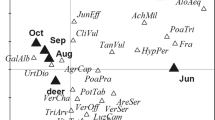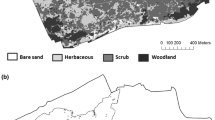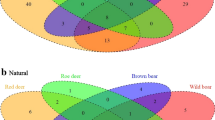Abstract
Endozoochrous seed dispersal by herbivorous mammals has been verified repeatedly and its possible influence on the structure and function of herbaceous communities has been suggested. Quantitative studies, however, are lacking in the field of seed dispersal via the dung of herbivore guilds in little-altered environments. The present paper analyses seed dispersal via rabbit, fallow deer, red deer and cow dung in a Mediterranean dehesa (open woodland used for hunting and ranching) during the seeding season. Dung seed content was determined by the glasshouse cultivation of eight dung samples from each herbivore, collected fortnightly between February and August. The four herbivores disperse many seeds (spring averages are 6–15 seeds per gram of dry dung and maxima of 25–70) from a large number of species (totals between 52 and 78). Dispersal seems to be mainly determined by seed production of the plant comminity. This is reflected in (i) the dissemination of a high percentage of the species present in the dehesa, (ii) great seasonal variability, related to seed production, in the amount of seeds and number of species dispersed, and (iii) a high semi-quantitative similarity of seed content in the four types of herbivore dung throughout the year. There is also important quantitative variation that depends on animal traits and feeding habits. These results and the characteristics of species found in dung suggest the adaptation of plant species to the dispersal of their seeds via herbivore gut. This process may well have profound implications for vegetation dynamics and the evolution of plant traits.
Similar content being viewed by others
References
Aschmann H (1973) Man's impact on the several regions with mediterranean climates. In: Castri F di, Mooney HA (eds) Mediterranean type ecosystems. Origins and structure. Springer. Berlin Heidelberg New York, pp 11–19
Baker HG (1974) The evolution of weeds. Annu Rev Ecol Syst 5: 1–24
Braza F, Alvarez F (1987) Habitat use by red deer and fallow deer in Doñana National Park. Misc Zool 11:363–367
Coughenour MB (1991) Spatial components of plant-herbivore interactions in pastoral, ranching, and native ungulate ecosystems. J Range Manage 44:530–542
D' Antonio CM, Vitousek PM (1992) Biological invasions by exotic grasses, the grass/fire cycle, and global change. Annu Rev Ecol Systs 23:63–87
De Miguel JM (1988) Estructura de un sistema silvopastoral de dehesa. Vegetación, hábitats y uso del territorio por el ganado. Ph D. Thesis, Universidad Complutense de Madrid
Dinerstein E (1991) Seed dispersal by greater one-horned rhinoceros (Rhinoceros unicornis) and the flora of Rhinoceros latrines. Mammalia 55:353–362
Gardener CJ (1993) The colonization of a tropical grassland by Stylosanthes from seed transported in cattle faeces. Aust J Agric Res 44:299–315
Gardener CJ, McIvor JG, Jansen A (1993a) Survival of seeds of tropical grassland species subjected to bovine digestion. J Appl Ecol 30:75–85
Gardener CJ, McIvor JG, Jansen A (1993b) Passage of legume and grass seeds through the digestive tract of cattle and their survival in faeces. J Appl Ecol 30:63–74
Gómez JM (1991) Origenes del monte adehesado y situación actual. In: Gómez JM (ed) El libro de las dehesas salmantinas. Consejería de Medio Ambiente y Ordenación del territorio, Junta de Castilla y León, Salamanca, pp 23–33
Gordon IJ, Illius AW (1989) Resource partitioning by ungulates on the Isle of Rhum. Oecologia 79:383–389
Grime JP, Hodgson JG, Hunt R (1988) Comparative plant ecology: a functional approach to common British species. Unwin Hyman, London
Herrera CM (1984) Tipos morfológicos y funcionales en plantas del matorral mediterráneo del Sur de España. Stvd Oecol 5: 7–34
Hofmann RR (1989) Evolutionary steps of ecophysiological adaptation and diversification of ruminants: a comparative view of their digestive system. Oecologia 78:443–457
Janzen DH (1982) Differential seed survival and passage rates in cows and horses, surrogate Pleistocene dispersal agents. Oikos 38:150–156
Janzen DH (1983) The dispersal of small seeds by vertebrate guts. In: Futuyma DJ, Slatkin M (eds) Coevolution. Sinauer, Sunderland, pp 232–262
Janzen DH (1984) Dispersal of small seeds by big herbivores: foliage is the fruit, Am Nat 123:338–353
Jones RM, Noguchi M, Bunch GA (1991) Levels of germinable seed in topsoil and cattle faeces in legume-grass and nitrogen-fertilized pastures in south-east Queensland. Aust J Agric Res 42:953–968
Levassor C, Ortega M, Peco B (1990) Seed bank dynamics of Mediterranean pastures subjected to mechanical disturbance. J Veg Sci 1:339–344
Malo JE (1994) Dispersión endozzócora por el ganado ovino en áreas sometidas al abandono de las labores agrícolas tradicionales. Actas de la XXXIV reunión científica de la sociedad española para el estudio de los pastos. S.E.E.P., Caja de Cantabria, Santander, pp 53–58
Malo JE, Suárez F (1994) Dispersión endozoócora por el gamo (Dama dama L.) e introducción de especies con el pastoreo. Pastos 24 (in press)
Malo JE, Suárez F (1995) Establishment of pasture species on cattle dung pats. The role of endozoochorally dispersed seeds. J Veg Sci 6:169–174
Malo JE, Jiménez B, Suárez F (1995) Seed bank regeneration in small pasture gaps: the contribution of endozoochorous dispersal by rabbits. Ecography 18:73–82
Miller MF (1993) Is it advantageous for Acacia seeds to be eaten by ungulates? Oikos 66:364–368
Montangue WD, Van Soest PJ (1985) A nutritional explanation of body-size patterns of ruminant and nonruminant herbivores. Am Nat 125:641–672
Neff DJ (1968) The pellet-group technique for big game trend, census, and distribution: a review. J Wildl Manage 32: 597–614
Ridley HN (1930) Tge dispersal of plants throughout the world. Reeve, Ashford
Russi L, Cocks PS, Roberts EH (1992a) The fate of legume seeds eaten by sheep from a Mediterranean grassland. J Appl Ecol 29:772–778
Russi L, Cocks PS, Roberts EH (1992b) Seed bank dynamics in a Mediterranean grassland. J Appl Ecol 29:773–771
Soriguer R (1986) The rabbit as a plant seed disperser. Mammal Rev 16:197–198
Soriguer R (1988) Alimentación del conejo (Oryctolagus cuniculus L. 1758) en Doñana, SO España. Doñana Acta Vertebrata 15:141–150
Staniforth RJ, Cavers PB (1977) The importance of cottontail rabbits in the dispersal of Polygonum spp. J Appl Ecol 14: 261–267
SYSTAT (1992) SYSTAT for Windows: statistics, version 5 edn. Systat Inc., Evanston
Tutin TG, Heywood VH, Burges NA, Valentine DH, Walters SM, Webb DA (1964–1980) Flora europea, vols 1–5. Cambridge Univ Press, Cambridge
Welch D (1985) Studies in the grazing of heather moorland in north-east Scotland. IV. Seed dispersal and plant establishment in dung. J Appl Ecol 22:461–472
Wood DH (1988) Estimating rabbit density by counting dung pellets. Aust Wildl Res 15:665–671
Zedler PH, Black C (1992) Seed dispersal by a generalized herbivore: rabbits as dispersal vectors in a semiarid California vernal pool landscape. Am Midl Nat 128:1–10
Author information
Authors and Affiliations
Rights and permissions
About this article
Cite this article
Malo, J.E., Suárez, F. Herbivorous mammals as seed dispersers in a Mediterranean dehesa . Oecologia 104, 246–255 (1995). https://doi.org/10.1007/BF00328589
Received:
Accepted:
Issue Date:
DOI: https://doi.org/10.1007/BF00328589




